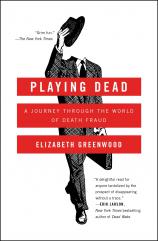Playing Dead: A Journey Through the World of Death Fraud
Review
Playing Dead: A Journey Through the World of Death Fraud
Ever thought life would be better if you were somebody else? Or that you needed to completely escape yourself? Turns out you’re not the only one. In PLAYING DEAD, Elizabeth Greenwood investigates the many angles behind death fraud --- why you might do it, how you might do it, how hard it is to pull off, and who might track you down. She also explores death conspiracies with true believers doggedly awaiting their heroes’ returns.
Death fraud is an undeniably intriguing rabbit hole. At its most basic level, properly executed death fraud is a lifetime of uncertainty, both for executor and survivors. Though Greenwood claims her initial interest arose from feeling trapped by debt, it seems more likely she seized the subject because of the same combination of facetiousness and good instincts for human interest stories that she displays as an author and interviewer.
Like any good gumshoe, Greenwood starts by examining people with expertise in the field of pseudocide. Given the extreme difficulty of finding people who have successfully pulled it off (for some reason, success stories tend to keep their glory under wraps), Greenwood goes for the next best thing: the people who help them and their counterparts --- the people who catch them.
"The sections of the book describing the intricacies of bureaucratic proof are among the most compelling."
The first we meet in the form of Frank Ahearn, an expert of the disappearing act, who is mostly an expert of misinformation. His main tool of combat is a flood of inconsistent and incorrect information about his subject in the hopes that whoever is looking for them will back off. Most of his clients (and pseudocide practitioners in general) fit a specific profile: male with some financial resources, though often in trouble, and a healthy ego. The man on the other side is Steve Rambam, a “most-interesting-man-in-the-world” type who pounds pavement until the job is done. Rambam consults for The Man, in the form of the insurance companies trying to substantiate sizable insurance claims.
The sections of the book describing the intricacies of bureaucratic proof are among the most compelling. It’s not as obvious as handing over a death certificate anymore, in part because, as Greenwood illustrates by breezily getting one for herself, those are too easy to come by. It’s a matter of witnesses, remains, hospital records and independent verification.
The pseudociders’ various undoings also arise from less obvious incidents than one might expect. Today, pseudocode is more complex than avoiding previous acquaintances or opening a new line of credit; it’s also a matter of hiding IP addresses, off-shore accounts and social media. Sometimes people are caught for the act, but more often it seems they’re picked up on more quotidian incidentals --- the traffic stops, online check-ins, and wife-vs-mistress balancing acts that are the undoing of so many nefarious and pathetic schemes.
Sadly, the book does not live up to its most compelling promises: It neither gives the reader a moving picture of the internal conflict surrounding an individual pseudocide, nor does it tell how to fake your own death. Greenwood gets kind of close to the former, interviewing a few people who have gone through with the plan and almost honing in on those dark and deep spaces that must exist in the soul of a person who decides to abandon their identity. It’s unfortunate she doesn’t go further.
Some redemption comes in the form of a few practical takeaways: Drowning is not as foolproof as you think. You can’t come back. And don’t own a car.
Reviewed by Rebecca Kilberg on August 12, 2016
Playing Dead: A Journey Through the World of Death Fraud
- Publication Date: August 15, 2017
- Genres: Nonfiction, True Crime
- Paperback: 272 pages
- Publisher: Simon & Schuster
- ISBN-10: 147673934X
- ISBN-13: 9781476739342





